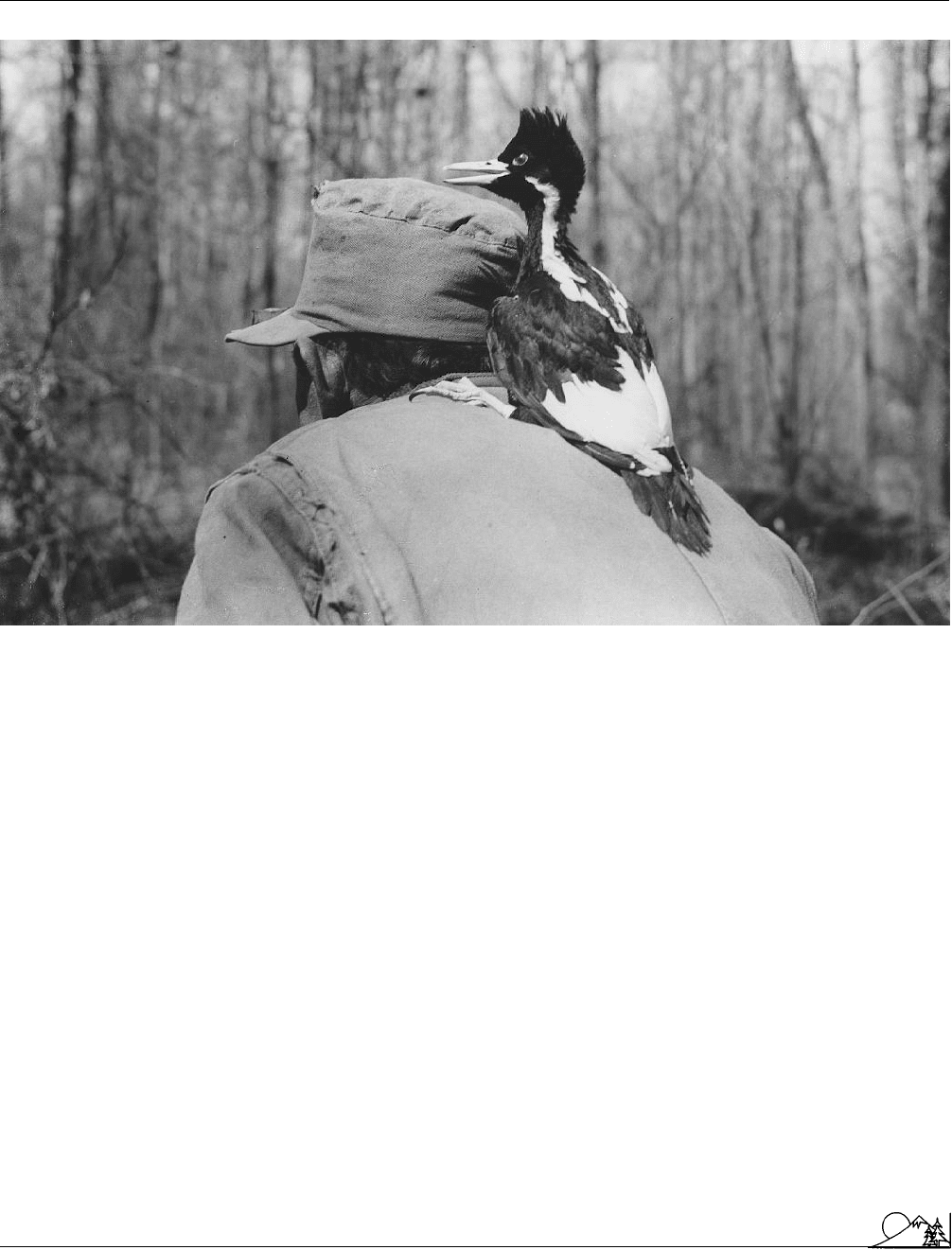Environmental Encyclopedia
Подождите немного. Документ загружается.


Environmental Encyclopedia 3
ISO 14000: International Environmental Management Standards
R
ESOURCES
B
OOKS
Harris, Larry D. The Fragmented Forest: Island Biogeography Theory and the
Preservation of Biotic Diversity. Chicago: University of Chicago Press, 1984.
Mac Arthur, Robert H., and Edward O. Wilson.The Theory of Island
Biogeography. Princeton: Princeton University Press, 1967.
Quaman, David. Song of the Dodo: Island Biogeography in an Age of Extinction.
New York: Scribner, 1996.
Whittaker, Robert J. Island Biogeography: Ecology, Evolution and Conserva-
tion. London: Oxford University Press, 1999.
P
ERIODICALS
Grant, P. R. “Competition Exposed by Knight?” Nature 396: 216–217.
O
THER
“Island Biogeography.” University of Oxford School of Geography and the
Environment. August 7, 2000 [cited June 26, 2002]. <http://www.geog.ox.-
ac.uk/research/bie/islandbio/index.html>.
O
RGANIZATIONS
Environmental Protection Agency (EPA), 1200 Pennsylvania Avenue,
NW, Washington, DC USA 20460 (202) 260-2090, Email: public-
access@epa.gov, <http://www.epa.gov>
ISO 14000: International
Environmental Management
Standards
ISO 14000 refers to a series of environmental management
standards that were adopted by the International Organiza-
tion for Standardization (ISO) in 1996 and are beginning
to be implemented by businesses across the world. Any
person or organization interested in the
environment
and
in the goal of improving environmental performance of busi-
nesses should be interested in ISO 14000. Such interested
parties include businesses themselves, their legal representa-
tives, environmental organizations and their members, gov-
ernment officials, and others.
What is the ISO and what are ISO standards?
The International Organization for Standardization
(ISO) is a private (nongovernmental) worldwide organiza-
tion whose purpose is to promote uniform standards in inter-
national trade. Its members are elected representatives from
national standards organizations in 111 countries. The ISO
covers all fields involving promoting goods, services, or prod-
ucts and where a Member Body suggests that standardization
is desirable, with the exception of electrical and electronic
engineering, which are covered by a different organization
called the International Electrotechnical Commission
(IEC). However, the ISO and the IEC work closely to-
gether.
Since the ISO began operations in 1947, its Central
Secretariat has been located in Geneva, Switzerland. Be-
tween 1951 (when it published its first standard) and 1997,
the ISO issued over 8,800 standards. Standards are docu-
777
ments containing technical specifications, rules, guidelines,
and definitions to ensure equipment, products, and services
perform as specified.
Among the best known standards published by the
ISO are those that comprise the ISO 9000 series, which
was developed between 1979–1986, and published in 1987.
Because ISO 9000 is a forerunner to ISO 14000, it is impor-
tant to understand the basic structure and function of ISO
9000. The ISO 9000 series is a set of standards for quality
management and quality assurance. The standards apply to
processes and systems that produce products; they do not
apply to the products themselves. Further, the standards
provide a general framework for any industry; they are not
industry-specific. A company that has become registered
under ISO 9000 has demonstrated that it has a documented
system for quality that is in place and consistently applied.
ISO 9000 standards apply to all kinds of companies whether
large or small, in services or manufacturing.
The latest major set of standards published by the ISO
is the ISO 14000 series. The impetus for that series came
from the United Nations Conference on the Environment
and Development (UNCED), which was held in Rio De
Janeiro in 1992 and attended by representatives of over one
hundred nations. One of the documents resulting from that
conference was the Global Environmental Initiative, which
prompted the ISO to develop its ISO 14000 series of interna-
tional environmental standards. The ISO’s goal is to insure
that businesses adopt common internal procedures for envi-
ronmental controls including, but not limited to, audits. It
is important to note that the standards are process standards,
not performance standards. The goal is to ensure that busi-
nesses are in compliance with their own national and local
applicable environmental laws and regulations. The initial
standards in the series include numbers 14001, 14004, and
14010-14012; all of them adopted by the ISO in 1996.
Provisions of ISO 14000 Series standards
ISO 14000 sets up criteria pursuant to which a com-
pany may become registered or certified as to its environmen-
tal management practices.
Central to the process of registration pursuant to ISO
14000 is a company’s Environmental Management System
(EMS). The EMS is a set of procedures for assessing compli-
ance with environmental laws and company procedures for
environmental protection, identifying and resolving with
problems, and engaging the company’s workforce in a com-
mitment to improved environmental performance by the
company.
ISO 14001 series can be divided into two groups:
guidance documents and specification documents. The series
sets out standards against which a company’s EMS will be
evaluated. For example, it must include an accurate summary
of the legal standards with which the company must comply,

Environmental Encyclopedia 3
ISO 14000: International Environmental Management Standards
such as permit stipulations, and relevant provisions of stat-
utes and regulations, and even provisions of administrative
or court-certified consent judgments. To become certified,
the EMS must: (1) include an
environmental policy
; (2)
establish plans to meet environmental goals and comply with
legal requirements; (3) provide for implementation of the
policy and operation under it including training for person-
nel, communication, and document control; (4) set up moni-
toring and measurement devices and an audit procedure to
insure continuing improvement; and (5) provide for manage-
ment review. The EMS must be certified by a registrar who
has been qualified under ISO 13012, a standard that predates
the ISO 14000 series.
The ISO 14004 series is a guidance document that
gives advice that may be followed but is not required. It
includes five principles each of which corresponds to one of
the five areas of ISO 14001 listed above.
ISO 14010, 14011, and 14012 are auditing standards.
For example, 14010 covers general principles of
environ-
mental auditing
, and 14011 provides guidelines for
auditing of an Environmental Management System (EMS).
ISO 14012 provides guidelines for establishing qualifications
for environmental auditors, whether those auditors are inter-
nal or external.
Plans for additional standards within the ISO 14000 Se-
ries standards
The ISO is considering proposals for standards on
training and certifying independent auditors (called regis-
trars) who will certify that ISO 14000-certified business
have established and adhere to stringent internal systems to
monitor and improve their own environmental protection
actions. Later the ISO may also establish standards for as-
sessing a company’s environmental performance. Standards
may be adopted to for use of eco-labeling and
life cycle
assessment
of goods involved in international trade.
Benefits and consequences of ISO 14000 Series stan-
dards
A company contemplating obtaining ISO 14000 regis-
tration must evaluate its potential advantages as well as its
costs to the company.
ISO 14000 certification may bring various rewards to
companies. For example, many firms are hoping that, in
return for obtaining ISO 14000 certification (and the actions
required to do so), regulatory agencies such as the U.S.
Environmental Protection Agency
(EPA) will give them
more favorable treatment. For example, leniency might be
shown in less stringent filing or monitoring requirements
or even less severe sanctions for past or present violations
of environmental statutes and regulations.
Further, compliance may be merely for good public
relations, leading consumers to view the certified company
778
as a good corporate citizen that works to protect the environ-
ment. There is public pressure on companies to demonstrate
their environmental stewardship and accountability; ob-
taining ISO 14000 certification is one way to do so.
The costs to the company will depend on the scope
of the Environmental Management System (EMS). For ex-
ample, the EMS might be international, national, or limited
to individual plants operated by the company. That decision
will affect the costs of the environmental audit considerably.
National and international systems may prove to be costly.
On the other hand, a company may realize cost savings.
For example, an insurance company may give reduced rates
on insurance to cover accidental
pollution
releases to a com-
pany that has a proven environmental management system
in place. Internally, by implementing an EMS, a company
may realize cost savings as a result of
waste reduction
, use
of less fewer toxic
chemicals
, less energy use, and
recycling
.
A major legal concern raised by lawyers studying the
ISO 14000 standards relates to the question of confidential-
ity. There are serious questions as to whether a governmental
regulatory agency can require disclosure of information dis-
covered during a self-audit by a company. The use of a
third-party auditor during preparation of the EMS process
may weaken a company’s argument that information discov-
ered is privileged.
ISO 14000 has potential consequences with respect
to international law as well as international trade. ISO 14000
is intended to promote a series of universally accepted EMS
practices and lead to consistency in environmental standards
between and among trading partners. Some developing
countries such as Mexico are reviewing ISO 14000 standards
and considering incorporating their provisions within their
own environmental laws and regulations. On the other hand,
some developing countries have suggested that environmen-
tal standards created by ISO 14000 may constitute non-
tariff barriers to trade in that costs of ISO 14000 registration
may be prohibitively high for small- to medium-size com-
panies.
Companies that have implemented ISO 9000 have
learned to view their companies’ operations through a “qual-
ity of management” lens and implementation of ISO 14000
may lead to use of “environmental quality” lens. ISO 14000
has the potential to lead to two kinds of cultural changes.
First, within the corporation, it has the potential to lead to
consideration of environmental issues throughout the com-
pany and its business decisions ranging from hiring of em-
ployees to marketing. Second, ISO 14000 has the potential
to become part of a global culture as the public comes to
view ISO 14000 certification as a benchmark connoting
good environmental stewardship by a company.
[Paulette L. Stenzel]

Environmental Encyclopedia 3
Itai-itai disease
R
ESOURCES
B
OOKS
Tibor, T., and I. Feldman. ISO 14000: A Guide to the New Environmental
Management Standards. Irwin Publishing Company, 1996.
von Zharen, W. M. ISO 14000: Understanding the Environmental Standards.
Government Institutes, 1996.
P
ERIODICALS
Kass, S. L. “The Lawyer’s Role in Implementing ISO 14000.” Natural
Resources & Environment 3, no. 5 (Spring 1997).
Isotope
Different forms of atoms of the same element. Atoms consist
of a nucleus, containing positively-charged particles (pro-
tons) and neutral particles (neutrons), surrounded by nega-
tively-charged particles (electrons). Isotopes of an element
differ only in the number of neutrons in the nucleus and
hence in atomic weight. The nuclei of some isotopes are
unstable and undergo
radioactive decay
. An element can
have several stable and radioactive isotopes, but most ele-
ments have only two or three isotopes that are of any impor-
tance. Also, for most elements the radioactive isotopes are
only of concern in material exposed to certain types of radia-
tion sources.
Carbon
has three important isotopes with
atomic weights of 12, 13, and 14. C-12 is stable and repre-
sents 98.9% of natural carbon. C-13 is also stable and repre-
sents 1.1% of natural carbon. C-14 represents an insignifi-
cant fraction of naturally-occurring carbon, but it is
radioactive and important because its radioactive decay is
valuable in the dating of fossils and ancient artifacts. It is
also useful in tracing the reactions of carbon compounds in
research. See also Nuclear fission; Nuclear power; Radioactiv-
ity; Radiocarbon dating
Itai-itai disease
The symptoms of Itai-Itai disease were first observed in
1913 and characterized between 1947 and 1955; it was 1968,
however, before the Japanese Ministry of Health and Wel-
fare officially declared that the disease was caused by chronic
cadmium poisoning
in conjunction with other factors such
as the stresses of pregnancy and lactation, aging, and dietary
deficiencies of vitamin D and calcium. The name arose from
the cries of pain, “itai-itai” (ouch-ouch) by the most seriously
stricken victims, older Japanese farm women. Although men,
young women, and children were also exposed, 95% of the
victims were post-menopausal women over 50 years of age.
They usually had given birth to several children and had
lived more than 30 years within 2 mi (3 km) of the lower
stream of the Jinzu River near Toyama.
779
The disease started with symptoms similar to rheuma-
tism, neuralgia, or neuritis. Then came bone lesions, osteo-
malacia, and osteoporosis, along with renal disfunction and
proteinuria. As it escalated, pain in the pelvic region caused
the victims to walk with a duck-like gait. Next, they were
incapable of rising from their beds because even a slight
strain caused bone fractures. The suffering could last many
years before it finally ended with death. Overall, an estimated
199 victims have been identified, of which 162 had died by
December 1992.
The number of victims increased during and after
World War II as production expanded at the Kamioka Mine
owned by the Mitsui Mining and Smelting Company. As
3,000 tons of zinc-lead ore per day were mined and smelted,
cadmium was discharged in the
wastewater
. Downstream,
farmers withdrew the fine particles of
flotation tailings
in
the Jinzu River along with water for drinking and crop
irrigation
. As rice plants were damaged near the irrigation
inlets, farmers dug small
sedimentation
pools that were
ineffective against the nearly invisible poison.
Both the numbers of Itai-Itai disease patients and the
damage to the rice crops rapidly decreased after the mining
company built a large settling basin to purify the wastewater
in 1955. However, even after the
discharge
into the Jinzu
River was halted, the cadmium already in the rice paddy
soils was augmented by airborne exhausts. Mining operations
in several other Japanese prefectures also produced cad-
mium-contaminating rice, but afflicted individuals were not
certified as Itai-Itai patients. That designation was applied
only to those who lived in the Jinzu River area.
In 1972 the survivors and their families became the
first
pollution
victims in Japan to win a lawsuit against a
major company. They won because in 1939 Article 109 of
the Mining Act had imposed strict liability upon mining
facilities for damages caused by their activities. The plaintiffs
had only to prove that cadmium discharged from the mine
caused their disease, not that the company was negligent.
As epidemiological proof of causation sufficed as legal proof
in this case, it set a precedent for other pollution litigation
as well.
Despite legal success and compensation, the problem
of contaminated rice continues. In 1969 the government
initially set a maximum allowable standard of 0.4
parts
per million
(ppm) cadmium in unpolished rice. However,
because much of the contaminated farmland produced grain
in excess of that level, in 1970 under the Foodstuffs Hygiene
Law this was raised to 1 ppm cadmium for unpolished
rice and 0.9 ppm cadmium for polished rice. To restore
contaminated farmland, Japanese authorities instituted a
program in which, each year, the most highly contaminated
soils in a small area are exchanged for uncontaminated soils.
Less contaminated soils are rehabilitated through the addi-

Environmental Encyclopedia 3
IUCN—The World Conservation Union
tion of lime, phosphate, and a cadmium sequestering agent,
EDTA.
By 1990 about 10,720 acres (4,340 ha), or 66.7% of
the approximately 16,080 acres (6,510 ha) of the most highly
cadmium contaminated farmland had been restored. In the
remaining contaminated areas where farm families continue
to eat homegrown rice, the symptoms are alleviated by treat-
ment with massive doses of vitamins B1, B12, D, calcium,
and various hormones. New methods have also been devised
to cause the cadmium to be excreted more rapidly. In addi-
tion, the high costs of compensation and restoration are
leading to the conclusion that prevention is not only better
but cheaper. This is perhaps the most encouraging factor of
all. See also Bioaccumulation; Environmental law; Heavy
metals and heavy metal poisoning; Mine spoil waste;
Smelter; Water pollution
[Frank M. D’Itri]
R
ESOURCES
B
OOKS
Kobayashi, J. “Pollution by Cadmium and the Itai-Itai Disease in Japan.”
In Toxicity of Heavy Metals in the Environment, Part 1, edited by F. W.
Oehme. New York: Marcel Dekker, 1978.
Kogawa, K. “Itai-Itai Disease and Follow-Up Studies.” In Cadmium in the
Environment, Part II, edited by J. O. Nriagu. New York: Wiley, 1981.
Tsuchiya, K., ed. Cadmium Studies in Japan: A Review. Tokyo, Japan, and
Amsterdam, Netherlands: Kodansha and Elsevier/North-Holland Biomed-
ical Press, 1978.
IUCN—The World Conservation Union
Founded in 1948 as the International Union for the Conser-
vation of Nature and Natural Resources (IUCN), IUCN
works with governments, conservation organizations, and
industry groups to conserve
wildlife
and approach the
world’s environmental problems using “sound scientific in-
sight and the best available information.” Its membership,
currently over 980, comes from 140 countries and includes
56 sovereign states, as well as government agencies and
nongovernmental organizations. IUCN exists to serve its
members, representing their views and providing them with
the support necessary to achieve their goals. Above all, IUCN
works with its members “to achieve development that is
sustainable and that provides a lasting improvement in the
quality of life for people all over the world.” IUCN’s three
basic conservation objectives are: (1) to secure the conserva-
tion of nature, and especially of biological diversity, as an
essential foundation for the future; (2) to ensure that where
the earth’s natural resources are used this is done in a wise,
equitable, and sustainable way; (3) to guide the development
of human communities toward ways of life that are both of
780
good quality and in enduring harmony with other compo-
nents of the
biosphere
.
IUCN is one of the few organizations to include both
governmental agencies and nongovernmental organizations.
It is in a unique position to provide a neutral forum where
these organizations can meet, exchange ideas, and build
partnerships to carry out conservation projects. IUCN is also
unusual in that it both develops environmental policies and
then implements them through the projects it sponsors.
Because the IUCN works closely with, and its membership
includes, many government scientists and officials, the orga-
nization often takes a conservative, pro-management, as op-
posed to a “preservationist,” approach to wildlife issues. It
may encourage or endorse limited
hunting
and commercial
exploitation of wildlife if it believes this can be carried out
on a sustainable basis.
IUCN maintains a global network of over 5,000
scientists and wildlife professionals who are organized into
six standing commissions that deal with various aspects
of the union’s work. There are commissions on Ecology,
Education, Environmental Planning,
Environmental Law
,
National Parks and Protected Areas, and
Species
Survival.
These commissions create action plans, develop policies,
advise on projects and programs, and contribute to IUCN
publications, all on an unpaid, voluntary basis.
IUCN publishes an authoritative series of “Red Data
Books,” describing the status of rare and endangered wildlife.
Each volume provides information on the population, distri-
bution,
habitat
and ecology, threats, and protective mea-
sures in effect for listed species. The “Red Data Books”
concept was originated in the mid-1960s by the famous
British conservationist Sir Peter Scott, and the series now
includes a variety of publication on regions and species.
Other titles in the series of “Red Data Books” include Dol-
phins, Porpoises, and Whales of the World; Lemurs of Madagas-
car and the Comoros; Threatened Primates of Africa; Threatened
Swallowtail Butterflies of the World; Threatened Birds of the
Americas; and books on plants and other species of wildlife,
including a series of conservation action plans for threatened
species.
Other notable IUCN works include World Conserva-
tion Strategy: Living Resources Conservation for Sustainable
Development and its successor document Caring for the
Earth—A Strategy for Sustainable Living; and the United
Nations List of Parks and Protected Areas. IUCN also
publishes books and papers on regional conservation, habi-
tat preservation, environmental law and policy, ocean ecol-
ogy and management, and conservation and development
strategies.
[Lewis G. Regenstein]

Environmental Encyclopedia 3
Ivory-billed woodpecker
R
ESOURCES
O
RGANIZATIONS
IUCN—The World Conservation Union Headquarters, Rue Mauverney
28, Gland, Switzerland CH-1196 ++41 (22) 999-0000, Fax: ++41 (22)
999-0002, Email: mail@hq.iucn.org, <http://www.iucn.org>
Ivory-billed woodpecker
The ivory-billed woodpecker (Campephilus principalis) is one
of the rarest birds in the world and is considered by most
authorities to be extinct in the United States. The last con-
firmed sighting of ivory-bills was in Cuba in 1987 or 1988.
Though never common, the ivory-billed woodpecker was
rarely seen in the United States after the first years of the
twentieth century. Some were seen in Louisiana in 1942,
and since then, occasional sightings have been unverified.
Interest in the bird rekindled in 1999, when a student at
Louisiana State University claimed to have seen a pair of
ivory-billed woodpeckers in a
wilderness
preserve. Teams
of scientists searched the area for two years. No ivory-billed
woodpecker was sighted, though some evidence made it
plausible the bird was in the vicinity. By mid-2002, the ivory-
billed woodpecker’s return from the brink of
extinction
remained a tantalizing possibility, but not an established fact.
The ivory-billed woodpecker was a huge bird, averag-
ing 19–20 in (48–50 cm) long, with a wingspan of over 30
in (76 cm). The ivory-colored bills of these birds were prized
as decorations by native Americans. The naturalist John
James Audubon found ivory-billed woodpecker in swampy
forest edges in Texas in the 1830s. But by the end of the
nineteenth century, the majority of the bird’s prime
habitat
had been destroyed by
logging
. Ivory-billed woodpeckers
required large tracts of land in the bottomland cypress, oak,
and black gum forests of the Southeast, where they fed off
insect larva in mature trees. This
species
was the largest
woodpecker in North America, and they preferred the largest
of these trees, the same ones targeted by timber companies
as the most profitable to harvest. The territory for breeding
pairs of ivory-billed woodpeckers consists of about three
square miles of undisturbed, swampy forest, and there was
little prime habitat left for them after 1900, for most of
these areas had been heavily logged. By the 1930s, one of
the only virgin cypress swamps left was the Singer Tract in
Louisiana, an 80,000-acre (32,375-ha) swathe of land owned
by the Singer Sewing Machine Company. In 1935 a team
of ornithologists descended on it to locate, study, and record
some of the last ivory-billed woodpeckers in existence. They
found the birds and were able to film and photograph them,
as well as make the only sound recordings of them in exis-
tence. The Audubon Society, the state of Louisiana, and
the U.S.
Fish and Wildlife Service
tried to buy the land
from Singer to make it a refuge for the rare birds. But Singer
781
had already sold timber rights to the land. During World
War II, when demand for lumber was particularly high, the
Singer Tract was leveled. One of the giant cypress trees that
was felled contained the nest and eggs of an ivory-billed
woodpecker. Land that had been virgin forest then became
soybean fields.
Few sightings of these woodpeckers were made in the
1940s, and none exist for the 1950s. But in the early 1960s
ivory-billed woodpeckers were reported seen in South Caro-
lina, Texas, and Louisiana. Intense searches, however, left
scientists with little hope by the end of that decade, as only
six birds were reported to exist. Subsequent decades yielded
a few individual sightings in the United States, but none
were confirmed.
In 1985 and 1986, there was a search for the Cuban
subspecies of the ivory-billed woodpecker. The first expedi-
tion yielded no birds, but trees were found that had appar-
ently been worked by the birds. The second expedition found
at least one pair of ivory-billed woodpeckers. Most of the
land formerly occupied by the Cuban subspecies was cut
over for sugar cane plantations by the 1920s, and surveys in
1956 indicated that this population had declined to about
a dozen birds. The last reported sightings of the species
occurred in the Sierra de Moa area of Cuba. They are still
considered to exist there, but the health of any remaining
individuals must be in question, given the
inbreeding
that
must occur with such a low population level and the fact
that so little suitable habitat remains.
In 1999, a student at Louisiana State University (LSU)
claimed to have seen a pair of ivory-billed woodpeckers
while he was
hunting
for turkey in the Pearl River
Wildlife
Management
Area near the Louisiana-Mississippi border.
The student, David Kulivan, was a credible witness, and he
soon convinced ornithologists at LSU to search for the birds.
News of the sighting attracted thousands of amateur and
professional birders over the next two years. Scientists from
LSU, Cornell University, and the Louisiana Department of
Wildlife
and Fisheries organized an expedition that included
posting of high-tech listening devices. Over more than two
years, no one else saw the birds, though scientists found
trunks stripped of bark, characteristic of the way the ivory-
billed woodpecker feeds, and two groups heard the distinct
double rapping sound the ivory-billed woodpecker makes
when it knocks a trunk. No one heard the call of the ivory-
billed woodpecker, though this sound would have been con-
sidered definitive evidence of the ivory-billed woodpecker’s
existence. Hope for confirmation of Kulivan’s sighting rested
on deciphering the tapes made by a dozen recording devices.
This was being done at Cornell University, and was expected
to take years.
By mid-2002, the search for the ivory-billed wood-
pecker in Louisiana had wound down, disappointingly in-

Environmental Encyclopedia 3
Izaak Walton League
Ivory-billed woodpecker (
Campephilus
). (Photograph by James Tanner. Photo Researchers Inc. Reproduced by permission.)
conclusive. While some scientists remained skeptical about
the sighting, others believed that the forest in the area may
have regrown enough to support an ivory-billed woodpecker
population. See also Deforestation; Endangered species; Ex-
tinction; International Council for Bird Preservation; Wild-
life management
[Eugene C Beckham]
R
ESOURCES
B
OOKS
Collar, N. J., et al. Threatened Birds of the Americas: The ICBP/IUCN Red
Data Book. Washington, DC: Smithsonian Institution Press, 1992.
Ehrlich, P. R., D. S. Dobkin, and D. Wheye. The Birder’s Handbook. New
York: Simon & Schuster, 1988.
Ehrlich, P. R., D. S. Dobkin, and D. Wheye. Birds in Jeopardy: The Imperiled
and Extinct Birds of the United States and Canada, Including Hawaii and
Puerto Rico. Stanford: Stanford University Press, 1992.
P
ERIODICALS
Gorman, James. “Listening for the Call of a Vanished Bird” New York
Times, March 5, 2002, F1.
Graham, Frank Jr. “Is the Ivorybill Back?” Audubon (May/June 2000): 14.
782
Pianin, Eric. “Scientists Give Up Search for Woodpecker; Some Signs
Noted of Ivory-Billed Bird Not Seen Since ’40s” Washington Post, February
21, 2002, A2.
Tomkins, Shannon. “Dead or Alive?” Houston Chronicle, April 14, 2002, 8.
Izaak Walton League
In 1922, 54 sportsmen and sportswomen—all concerned
with the apparent destruction of American fishing water-
ways—established the Izaak Walton League of America
(IWLA). They looked upon Izaak Walton, a seventeenth-
century English fisherman and author of The Compleat An-
gler, as inspiration in protecting the waters of America. The
Izaak Walton League has since widened its focus: as a major
force in the American
conservation
movement, IWLA now
pledges in its slogan “to defend the nation’s
soil
, air, woods,
water, and wildlife.”
When sportsmen and sportswomen formed IWLA
approximately 70 years ago, they worried that American
industry would ruin fishing streams. Raw sewage, soil
ero-
sion
, and rampant
pollution
threatened water and
wildlife
.

Environmental Encyclopedia 3
Izaak Walton League
Initially the League concentrated on preserving lakes,
streams, and rivers. In 1927, at the request of President
Calvin Coolidge, IWLA organized the first national
water
pollution
inventory. Izaak Walton League members (called
“Ikes") subsequently helped pass the first national water
pollution control
act in the 1940s. In 1969 IWLA instituted
the Save Our Streams program, and this group mobilized
forces to pass the groundbreaking
Clean Water Act
of 1972.
The League did not only concentrate on the preservation
of American waters, however. From its 1926 campaign to
protect the black bass, to the purchase of a helicopter in 1987
to help game law officers protect waterfowl from poachers in
the Gulf of Mexico, IWLA has also been instrumental in
the preservation of wildlife. In addition, the League has
fought to protect public lands such as the National Elk
Refuge in Wyoming, the
Everglades National Park
, and
the Isle Royale National Park.
IWLA currently sponsors several environmental pro-
grams designed to conserve
natural resources
and educate
the public. The aforementioned Save Our Streams (SOS)
program is a grassroots organization designed to monitor
water quality
in streams and rivers. Through 200 chapters
nationwide, SOS promotes “stream rehabilitation” through
stream adoption kits and water pollution law training. An-
other program,
Wetlands
Watch, allows local groups to
purchase, adopt, and protect nearby wetlands. Similarly, the
Izaak Walton League Endowment buys land to save it from
unwanted development. IWLA’s Uncle Ike Youth Educa-
tion program aims to educate children and convince them
of the necessity of preserving the
environment
. A last major
program from the League is its internationally acclaimed
Outdoor Ethics program. Outdoor Ethics works to stop
poaching
and other illegal and unsportsmanlike outdoor
activities by educating hunters, anglers, and others.
The League also sponsors and operates regional con-
servation efforts. Its Midwest Office, based in Minnesota,
783
concentrates on preservation of the Upper Mississippi River
region. The
Chesapeake Bay
Program is a major regional
focus. Almost 25% of the “Ikes” live in the region of this
estuary
, and public education, awards, and local conserva-
tion projects help protect Chesapeake Bay. In addition the
Soil Conservation
Program focuses on combating soil ero-
sion and
groundwater pollution
, and the Public Lands
Restoration Task Force works out of its headquarters in
Portland, Oregon, to strike a balance between forests and
the desire for their natural resources in the West.
IWLA makes its causes known through a variety of
publications. Splash, a product of SOS, enlightens the public
as to how to protect streams in America. Outdoor Ethics,a
newsletter from the program of the same name, educates
recreationists to responsible practices of
hunting
, boating,
and other outdoor activities. The League also publishes a
membership magazine, Outdoor America, and the League
Leader, a vehicle of information for IWLA’s 2,000 chapter
and division officers. IWLA has also produced the longest-
running weekly environmental program on television. Enti-
tled Make Peace with Nature, the program has aired on PBS
for almost 20 years and presents stories of environmental
interest.
Having expanded its scope from water to the general
environment, IWLA has become a vital force in the national
conservation movement. Through its many and varied pro-
grams, the League continues to promote constructive and
active involvement in environmental problems.
[Andrea Gacki]
R
ESOURCES
O
RGANIZATIONS
Izaak Walton League of America, 707 Conservation Lane, Gaithersburg,
MD USA 20878 (301) 548-0150, Fax: (301) 548-0146, Toll Free: (800)
IKE-LINE, Email: general@iwla.org, <http://www.iwla.org>
This Page Intentionally Left Blank

J
Wes Jackson (1936 – )
American environmentalist and writer
Wes Jackson is a plant geneticist, writer, and co-founder,
with his wife Dana Jackson, of the
Land Institute
in Salina,
Kansas. He is one of the leading critics of conventional
agricultural practices, which in his view are depleting
topsoil
,
reducing genetic diversity, and destroying small family farms
and rural communities. Jackson is also critical of the culture
that provides the pretext and the context within which this
destruction occurs and is justified as “necessary,” “efficient,”
and “economical.” He contrasts a culture or mind-set that
emphasizes humanity’s mastery or dominion over
nature
with an alternative vision that takes “nature as the measure”
of human activity. The former viewpoint can produce tempo-
rary triumphs but not long-lasting or sustainable livelihood;
only the latter holds out the hope that humans can live with
nature, on nature’s terms.
Jackson was born in 1936 in Topeka, Kansas, the son
of a farmer. Young and restless, Jackson held various jobs—
welder, farm hand, ranch hand, teacher—before devoting
his time to the study of agricultural practices in the United
States and abroad. He attended Kansas Wesleyan University,
the University of Kansas, and North Carolina State Univer-
sity, where he earned his doctorate in plant genetics in 1967.
According to Jackson, agriculture as we know it is
unnatural, artificial, and, by geological time-scales, of rela-
tively recent origin. It requires plowing, which leads to loss
of topsoil, which in turn reduces and finally destroys fertility.
Large-scale “industrial” agriculture also requires large invest-
ments, complex and expensive machinery, fertilizers, pesti-
cides, and herbicides, and leads to a loss of genetic diversity,
to
soil erosion
and
compaction
, and other negative conse-
quences. It is also predicated on the planting and harvesting
of annual crops—corn, wheat, soybeans—that leaves fields
uncovered for long periods and thus leaves precious topsoil
unprotected and vulnerable to erosion by wind and water.
For every bushel of corn harvested, a bushel of topsoil is
lost. Jackson estimates that America has lost between one-
785
third and one-half of its topsoil since the arrival of the first
European settlers.
At the Land Institute, Jackson and his associates are
attempting to re-think and revise agricultural practices so as
to “make nature the measure” and enable farmers to “meet
the expectations of the land,” rather than the other way
around. In particular, they are returning to, and attempting
to learn from, the native
prairie
plants and the ecosystems
that sustain them. They are also exploring the feasibility of
alternative farming methods that might minimize or even
eliminate entirely the planting and harvesting of annual
crops, favoring instead the use of perennials that protect and
bind topsoil.
Jackson’s emphasis is not exclusively scientific or tech-
nical. Like his long-time friend Wendell Berry, Jackson
emphasizes the culture in agriculture. Why humans grow
food is not at all mysterious or problematic: we must eat in
order to live. But how we choose to plant, grow, harvest,
distribute, and consume food is clearly a cultural and moral
matter having to do with our attitudes and beliefs. Our
contemporary consumer culture is out of kilter, Jackson con-
tends, in various ways. For one, the economic emphasis on
minimizing costs and maximizing yields ignores longer-term
environmental costs that come with the depletion of topsoil,
the diminution of genetic diversity, and the depopulation of
rural communities. For another, most Americans have lost
(and many have never had) a sense of connectedness with
the land and the natural
environment
; Jackson contends
that they are unaware of the mysteries and wonder of birth,
death and rebirth, and of cycles and seasons, that are main-
stays of a meaningful human life. To restore this sense of
mystery and meaning requires what Jackson calls homecoming
and “the resettlement of America,” and “becoming native to
this place.” More Americans need to return to the land, to
repopulate rural communities, and to re-learn the wealth of
skills that we have lost or forgotten or never acquired. Such
skills are more than matters of method or technique, they
also have to do with ways of relating to nature and to each
other. Jackson has received several awards, such as the Pew

Environmental Encyclopedia 3
James Bay hydropower project
Conservation Scholars award (1990) and a MacArthur Fel-
lowship (1992).
Wes Jackson has been called, by critics and admirers
alike, a radical and a visionary. Both labels appear to apply.
For Jackson’s vision is indeed radical, in the original sense
of the term (from the Latin radix, or root). It is a vision
not only of “new roots for agriculture” but of new and deeper
roots for human relationships and communities that, like
protected prairie topsoil, will not easily erode.
[Terence Ball]
R
ESOURCES
B
OOKS
Berry, W. “New Roots for Agricultural Research.” In The Gift of Good
Land. San Francisco: North Point Press, 1981.
Eisenberg, E. New Roots for Agriculture. San Francisco: Friends of the
Earth, 1980.
Jackson, Wes. Altars of Unhewn Stone. San Francisco: North Point
Press, 1987.
———. Becoming Native to this Place. Lexington, KY: University Press of
Kentucky, 1994.
———, W. Berry, and B. Coleman, eds. Meeting the Expectations of the
Land. San Francisco: North Point Press, 1984.
P
ERIODICALS
Eisenberg, E. “Back to Eden.” The Atlantic (October 1989): 57–89.
James Bay hydropower project
James Bay forms the southern tip of the much larger
Hudson Bay in Quebec, Canada. To the east lies the
Quebec-Labrador peninsula, an undeveloped area with vast
expanses of pristine
wilderness
. The region is similar to
Siberia, covered in
tundra
and sparse forests of black
spruce and other evergreens. It is home to roughly 100
species
of birds, twenty species of fish and dozens of
mammals, including muskrat, lynx, black bear, red fox,
and the world’s largest herd of caribou. The area has also
been home to the Cree and other Native Indian tribes
for centuries. Seven rivers drain the wet, rocky region,
the largest being the La Grande.
In the 1970s, the government-owned Hydro-Quebec
electric utility began to divert these rivers,
flooding
3,861
square miles (10,000 km
2
) of land. They built a series of
reservoirs,
dams
and dikes on La Grande that generated
10,300 megawatts of power for homes and businesses in
Quebec, New York, and New England. With its $16 billion
price tag, the project is one of the world’s largest energy
projects. The complex generates a total of 15,000 megawatts.
A second phase of the project added two more hydroelectric
complexes, supplying another 12,000 megawatts of power--
786
the equivalent of more than thirty-five nuclear
power
plants
.
But the project has had many opponents. The Cree
and other Inuit tribes joined forces with American environ-
mentalists to protest the project. Its environmental impact
has had scant analysis; in fact, damage has been severe. Ten
thousand caribou drowned in 1984, while crossing one of
the newly-dammed rivers on their
migration
route. When
the utility flooded land, it destroyed
habitat
for countless
plants and animals. The graves of Cree Indians, who for
millennia, had hunted, traveled, and lived along the rivers,
were inundated. The project also altered the
ecology
of
the James and Hudson bays, disrupting spawning cycles,
nutrient
systems, and other important maritime resources.
Naturally-occurring
mercury
in rocks and
soil
is released
as the land is flooded and accumulates as it passes through
the food chain from microscopic organisms, to fish, to hu-
mans. A majority of the native people in villages where fish
are a main part of the diet show symptoms of mercury
poisoning
.
Despite these problems, Hydro-Quebec pursued the
project, partly because of Quebec’s long-standing struggle for
independence from Canada. The power is sold to corporate
customers, providing income for the province and attracting
industry to Quebec.
The Cree and environmentalists, joined by New York
congressmen, took their fight to court. On
Earth Day
1993,
they filed suit against New York Power Authority in United
States District Court in New York, challenging the legality
of the agreement, which was to go into effect in 1999. Their
claim was based on the United States Constitution and the
1916 Migratory Bird Treaty with Canada.
In February 2002, nearly 70 percent of Quebec’s James
Bay Cree Indians endorsed a 2.25 billion dollar deal with
the Quebec government for hydropower development on
their land. Approval for the deal ranged from a low of 50
percent, to a high of 83 percent, among the nine communi-
ties involved. Some Cree spokespersons considered the
agreement a vindication of the long campaign, waged since
1975, to have Cree rights respected.
Under the deal, the James Bay Cree would receive $16
million in 2002, $30.7 million in 2003, then $46.5 million
a year for 48 years. In return, the Cree would drop environ-
mental lawsuits totaling $2.4 billion. The Cree also agreed
to hydroelectric plants along the Eastman River and Rupert
River, subject to environmental approval. The deal guaran-
tees the Cree jobs with the hydroelectric authority and gives
them more control over
logging
and other areas of their
economy. See also Environmental law; Hetch Hetchy Reser-
voir; Nuclear energy
[Bill Asenjo Ph.D.]
